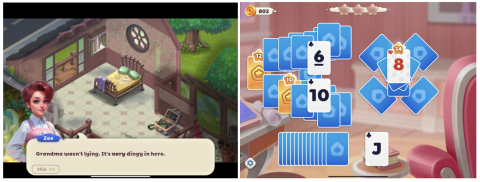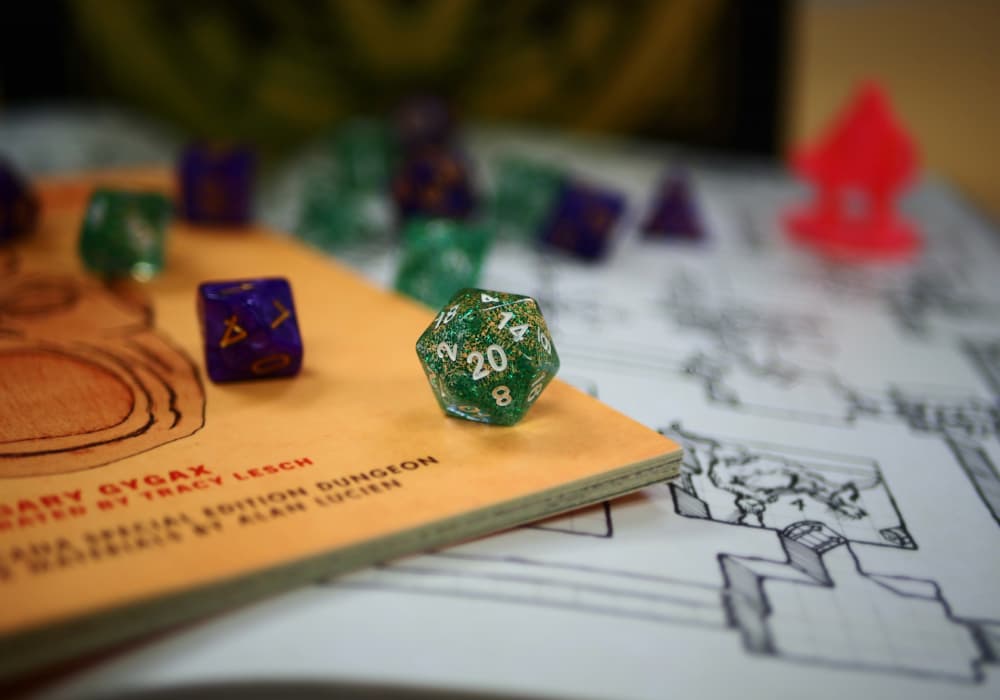What Are Story Driven Mobile Games?

Mobile gaming has had an undeniable burst of growth into one of the largest and most profitable types of gaming in recent years. Chief among this explosion sits the rise of story driven mobile games; they’ve not only redefined the (mobile) gaming experience, but the boundaries of storytelling itself.
If these sound like big claims, that’s because they are—but that doesn’t make them any less true. Let’s delve into the rapidly-developing world of story driven mobile games, and start unpacking why they’ve become such a driving force in the industry.
What’s the story with story driven mobile games, anyway?
Simply, story is entering mobile gaming for the same reason it’s entering the rest of gaming: retention. As the industry grows and markets saturate, it’s getting harder to keep players returning to your games rather than playing new ones. Stories can help combat this, as when integrated properly, they play on your:
- natural curiosity,
- emotional capacity,
- and need for closure.
In short, they withhold information and invest your feelings within the game’s characters and world, so you come back to learn a little more.
You see, as soon as you tell people about the tragic life of Scrappy the dog, and then ask them to spend a couple levels raising money for her vet bills, only to reveal that the results of their bake sale and the surgery itself are in the following level…. it’s more than likely that a few players will eagerly play through the next level to find out about poor ol’ Scrappy.
At least, that’s what the folks in production and business would say. Equally valid (and more so for me as a writer) is a story’s intrinsic value as moral entertainment.
Long before narrative games were expected or even respected in the industry, people have been making them—not because they kept players coming back and money coming in, but because they were a unique way to tell stories. No matter what platform or genre, no medium can give its audience the interactive and immersive narrative experience a game can.
As much as the industry seems to be slow at realising it at times, an awful lot of players keep coming back to games simply to escape inside fantastical stories and new experiences which they get a direct audio-visual way to react to. This opens up some pretty cool possibilities for writers like me to subject players to encounters I could never create any other way.
How do story driven mobile games do things differently?
Story driven mobile games occupy a particularly interesting niche within these possibilities, in that they are simultaneously
- doing worse,
- the same as,
- and better than
their PC and console counterparts at pushing the limits of interactive storytelling.
How story driven PC and console games handle narrative
For reference, AAA PC and console narrative titles as of late seem to focus on the creation of one largely linear story, built inside a nauseatingly expensive, self-contained and increasingly-interactive narrative world rendered with breathtaking virtual realism. These are worlds that the developers expect you to spend tens or even hundreds of dedicated hours in, so they take the time to pack their stories full of subplots to follow.Of course, more non-linear and branching examples exist (hello, Mass Effect and Skyrim), but recent games seem to be leaning more toward the linear side of things. You need only look at games like God of War: Ragnarok or the upcoming Avatar: Frontiers of Pandora to see how narrative-driven AAA has begun to master telling film-level stories with real morals, while still giving you free reign to explore their worlds over hours and hours.

Still, even these games are forevermore being expanded with narrative “branches”, or ways in which their story can change direction to accommodate player choice. The stories of these games have very much already become one of the core mechanics of the games themselves. Just like combat or crafting, the player’s narrative action now often impacts the direction of the game. What’s more, many games now use story options to allow access to exclusive cutscenes, levels or even entirely separate gameplay mechanics.
Therefore, how well games integrate stories into their player experience often has a major impact on how effective the story is as a tool both for entertainment and retention. If it feels disjointed, not only are you not going to enjoy it, but you’re probably not going to play it again.
But we were talking about story driven mobile games, weren’t we?
How mobile games with story handle narrative
In the shadow of this complex world of (narrative) PC and console gaming, mobile has always had somewhat of a need to prove itself as a platform. It has long held a debatable stereotype of being the platform of “fake” games, games that lack the complexity and skill requirement of “real” games.
This is partly down to mobiles only getting powerful enough for larger games somewhat recently, partly down to the mobile market being historically dominated by Hyper Casual genre, the main selling point of which being low complexity and low skill barriers, and partly down to how difficult it is to cater to every player’s expectations.
Hyper Casual has done so well historically because it fits the mobile as a platform. Most people have their phones on them throughout the day, and most of these people have a few minutes of boredom spread throughout that day—waiting for the bus, using the toilet, preheating the oven, and so on. So, it makes sense that story driven mobile games (and other mobile games) would be designed to be easily picked up and put down whenever there was a little time to play. This is still a major consideration for mobile games—you have to ensure your games won’t make players miss their bus, or be too confusing to dive back into, because otherwise players will uninstall it.

The perception towards mobile games with story today
However, as gaming has become more mainstream, and phones more powerful, people are willing to try bigger games that demand a little more attention. And as mobiles have become easier to develop more complex games for, two schools of thought have emerged in the (narrative) approach to the platform.
One side caters to the massive casual market most often. They explore how a strong narrative can bolster the uniqueness and retention of mobile games in a saturated space.
On the other side are more risk-tolerant developers keen on using the medium to push the definition of narrative-driven gaming. They take advantage of things like augmented reality (AR) and meta-storytelling to create entirely new genres of games.
But like with any commercialised art form, both the business and creative sides often experience significant overlap.
The result is that story driven mobile games can look like anything from a couple paragraphs about why a cute animal needs your help to solve puzzles within a certain timeframe, all the way up to PC and Console-scale fantasy Role-Playing Games like the (in)famous Raid: Shadow Legendswith their own characters and quests. In the middle sits a wide range of games, from virtual gamebooks to dating simulators, from short interactive films to pocket-sized MMOs.
And that, I think, is exactly why player interest in mobile games has been volatile compared to PC and console. Some mobile games are just simple puzzles with story lazily added for ‘more sales’, while others approach PC and console in size and complexity. More still are using the sheer number of mobiles to expose the masses to new kinds of stories. Some of them are even making entirely new genres with the unique qualities of mobiles themselves.

This experimental end of the platform is what I’m most interested in as a writer. Pokemon Go! is perhaps the best example of this, using the cameras and data connections of modern phones to turn them into mass AR systems, and then taking the world by storm by building a game around it.
People had to use their phone’s camera and GPS to find, catch and battle Pokemon. And suddenly, the real world and the people themselves became a living, breathing part of the Pokemon universe. The game cleverly relied on the physical adventures and interactions required to play the game to provide any story content outside of some worldbuilding (and the odd event). This phenomenon proved that the mobile platform is capable of its own unique narrative innovation.
Other examples include games (often dating simulators) that disguise themselves as messaging apps. It takes advantage of your familiarity with your phone as a communication device to blur the line between reality and fiction. I am still in love with this idea, but personally have yet to find a game that does it exceptionally well.
The one point to take away, though, is there are many story driven mobile games out there now—and their fanbases and revenue streams have firmly cemented them as a mainstay of the gaming industry. Many mobile gamers and mobile-only studios now rightly consider themselves gamers and games studios, where twenty years ago the market was all but nonexistent.
How can you spot good story driven mobile games?
These days, then, the question isn’t where to find story driven mobile games, but rather how to know when you’ve found a good one within such a saturated market.
Unfortunately, the biggest catch there is to what ‘good’ means, entirely depends on what kind of game it is you want to play. If you’re looking for a light platformer with a little lore behind it, you might not feel a branching sci-fi story game is ‘good’.
Still, here are some good ‘on-the-box’ indicators (in no particular order) of great story in story driven mobile games:
Multiple platforms
As phones have gotten more powerful, it’s increasingly common for small or even old PC and console games to be shipped to mobile to increase their reach. If the amount of work it takes to do it well has been invested, then it’s likely you’ve found something good. This is no small feat though.
Nice art/general quality
Similarly, if a game has had a lot of work put into its other features (UI, art, music, etc), then there’s a fair chance some attention was also given to its story. Beware, though—some developers overspend on art or music to hide bad writing.
Good reviews
Probably the most obvious, but for a good reason. They remain one of the best ways to judge the quality of a story driven mobile game by simply telling you what others thought.
Clear integration of story into mechanics
You should be able to tell from the app store page and screenshots how well the story fits into the game.
Do text boxes fit comfortably on the screen?
Are there easy ways to interact with a story?
Can you follow the plot easily?
What this will look like depends on the kind of game you’re looking at. But you’ll realise pretty quickly what bad integration looks like once you encounter it a few times.
Punchy, simplified-not-simple synopsis
On the same line, the synopsis on the game’s app store page should neatly and quickly paint the narrative picture. If you find yourself bored by uneventful stories or paragraphs of disjointed lore, it’s likely that the same standard of work carries over into the game itself.
List of quality story driven mobile games
If you’re still not sure where to start, or simply want some new story driven mobile games to try out, I’ve thrown together a list of my favourite free mobile games with storylines below:
Wizard’s Choice
Delight Games are perhaps one of the best text-adventure developers on mobile (to me, at least). Their games are easy to understand without being overly simple, feel immersive and interactive through their choices, and are often illustrated with some lovely pictures. Wizard’s Choice is the high-fantasy one I remember fondly from my teenage years, but they have released a variety of genres. If you’re all about gamebook-style storytelling, you’re doing yourself a disservice by not playing.
Perfume of Love
Tictales are renowned for their wonderful romance stories, and Perfume of Love is no exception. The app has a different story for each love interest it features, and each one is packed with intense choices and beautiful art—not to mention some steamy scenes. If romance games are your thing, this is the one to play.
Oxenfree
While the game is oddly only available on mobile for Netflix members (being on PC and console for everyone else), it’s well-deserving of the awards it has won. Oxenfree is an interactive coming-of-age horror story set in the 80s (with a brilliant plot) that I think goes to show how console-like interactive storytelling is becoming on mobile devices.
When The Past Was Around
This one’s an odd one. An award-winning indie game with some breathtaking art, this point-and-click adventure was ported from PC and tells its story primarily through puzzles and pictures, rather than words. It’s a different way of experiencing a narrative, and is emblematic of the widely-accessible experimentation the mobile platform facilitates. If you’re wondering how mobile has helped change the concept of the story driven game, this game can show you.
Give mobile games with story a try!
Generally, writing for interactive media is not easy! The complexity of narrative in mobile games is something to behold considering the number of constraints the narrative must work with. So I highly encourage you to explore some story driven mobile games you get your hands on. They may offer you something you don’t often get!
Interested in sharing your experience or writing a guest post for us? Chat with us on our social media (TikTok | Twitter | YouTube | Instagram | LinkedIn | Facebook) and we’ll consider something for you! Share this article with game lovers and let them know how it can help them discover or develop a brilliant game!















Add new comment